United States District Court for the District of Vermont
| United States District Court for the District of Vermont | |
|---|---|
| (D. Vt.) | |
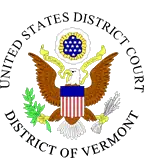 | |
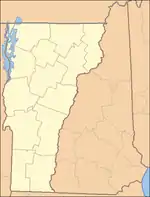 | |
| Location | Burlington More locations |
| Appeals to | Second Circuit |
| Established | March 2, 1791 |
| Judges | 2 |
| Chief Judge | Geoffrey W. Crawford |
| Officers of the court | |
| U.S. Attorney | Nikolas P. Kerest |
| U.S. Marshal | Bradley Jay LaRose |
| www | |
The United States District Court for the District of Vermont (in case citations, D. Vt.) is the federal district court whose jurisdiction is the federal district of Vermont. The court has locations in Brattleboro, Burlington, and Rutland. The court was created by a March 2, 1791 amendment (1 Stat. 197) to the Judiciary Act of 1789 and assigned to the eastern circuit. Under the Midnight Judges Act, the Circuits were reorganized and this court was assigned to the United States Court of Appeals for the Second Circuit where it has remained since. Originally created with one judgeship, in 1966 a second judgeship was added.
Appeals from the District of Vermont are taken to the United States Court of Appeals for the Second Circuit (except for patent claims and claims against the U.S. government under the Tucker Act, which are appealed to the Federal Circuit).
The United States Attorney's Office for the District of Vermont represents the United States in civil and criminal litigation in the court. As of December 10, 2021 the United States attorney is Nikolas P. Kerest.[1]
Current judges
As of December 21, 2017:
| # | Title | Judge | Duty station | Born | Term of service | Appointed by | ||
|---|---|---|---|---|---|---|---|---|
| Active | Chief | Senior | ||||||
| 20 | Chief Judge | Geoffrey W. Crawford | Rutland | 1954 | 2014–present | 2017–present | — | Obama |
| 19 | District Judge | Christina Reiss | Burlington | 1962 | 2009–present | 2010–2017 | — | Obama |
| 17 | Senior Judge | John Garvan Murtha | inactive | 1941 | 1995–2009 | 1995–2002 | 2009–present | Clinton |
| 18 | Senior Judge | William K. Sessions III | Burlington | 1947 | 1995–2014 | 2002–2010 | 2014–present | Clinton |
Vacancies and pending nominations
| Seat | Prior judge's duty station | Seat last held by | Vacancy reason | Date of vacancy | Nominee | Date of nomination |
|---|---|---|---|---|---|---|
| 2 | Rutland | Geoffrey W. Crawford | Senior status | August 9, 2024[2] | — | — |
Former judges
| # | Judge | State | Born–died | Active service | Chief Judge | Senior status | Appointed by | Reason for termination |
|---|---|---|---|---|---|---|---|---|
| 1 | Nathaniel Chipman | VT | 1752–1843 | 1791–1793 | — | — | Washington | resignation |
| 2 | Samuel Hitchcock | VT | 1755–1813 | 1793–1801[Note 1] | — | — | Washington | elevation to 2d Cir. |
| 3 | Elijah Paine | VT | 1757–1842 | 1801–1842 | — | — | J. Adams | resignation |
| 4 | Samuel Prentiss | VT | 1782–1857 | 1842–1857 | — | — | Tyler | death |
| 5 | David Allen Smalley | VT | 1809–1877 | 1857–1877 | — | — | Pierce | death |
| 6 | Hoyt Henry Wheeler | VT | 1833–1906 | 1877–1906 | — | — | Hayes | retirement |
| 7 | James Loren Martin | VT | 1846–1915 | 1906–1915[Note 2] | — | — | T. Roosevelt | death |
| 8 | Harland Bradley Howe | VT | 1873–1946 | 1915–1940 | — | 1940–1945 | Wilson | retirement |
| 9 | James Patrick Leamy | VT | 1892–1949 | 1940–1949 | — | — | F. Roosevelt | death |
| 10 | Ernest W. Gibson Jr. | VT | 1901–1969 | 1949–1969 | 1966–1969 | — | Truman | death |
| 11 | Bernard Joseph Leddy | VT | 1910–1972 | 1966–1972 | 1969–1972 | — | L. Johnson | death |
| 12 | James L. Oakes | VT | 1924–2007 | 1970–1971 | — | — | Nixon | elevation to 2d Cir. |
| 13 | James Stuart Holden | VT | 1914–1996 | 1971–1984 | 1972–1983 | 1984–1996 | Nixon | death |
| 14 | Albert Wheeler Coffrin | VT | 1919–1993 | 1972–1989 | 1983–1988 | 1989–1993 | Nixon | death |
| 15 | Franklin S. Billings Jr. | VT | 1922–2014 | 1984–1994 | 1988–1991 | 1994–2014 | Reagan | death |
| 16 | Fred I. Parker | VT | 1938–2003 | 1990–1994 | 1991–1994 | — | G.H.W. Bush | elevation to 2d Cir. |
- Recess appointment; formally nominated on December 27, 1793, confirmed by the United States Senate on December 30, 1793, and received commission on January 28, 1794
- Recess appointment; formally nominated on December 3, 1906, confirmed by the Senate on December 11, 1906, and received commission the same day
Chief judges
| Chief Judge | |||
|---|---|---|---|
| Gibson | 1966–1969 | ||
| Leddy | 1969–1972 | ||
| Holden | 1972–1983 | ||
| Coffrin | 1983–1988 | ||
| Billings | 1988–1991 | ||
| Parker | 1991–1994 | ||
| Murtha | 1995–2002 | ||
| Sessions | 2002–2010 | ||
| Reiss | 2010–2017 | ||
| Crawford | 2017–present | ||
Chief judges have administrative responsibilities with respect to their district court. Unlike the Supreme Court, where one justice is specifically nominated to be chief, the office of chief judge rotates among the district court judges. To be chief, a judge must have been in active service on the court for at least one year, be under the age of 65, and have not previously served as chief judge.
A vacancy is filled by the judge highest in seniority among the group of qualified judges. The chief judge serves for a term of seven years, or until age 70, whichever occurs first. The age restrictions are waived if no members of the court would otherwise be qualified for the position.
When the office was created in 1948, the chief judge was the longest-serving judge who had not elected to retire, on what has since 1958 been known as senior status, or declined to serve as chief judge. After August 6, 1959, judges could not become or remain chief after turning 70 years old. The current rules have been in operation since October 1, 1982.
Succession of seats
|
|
| ||||||||||||||||||||||||||||||||||||||||||||||||||||||||
U.S. attorneys
U.S. attorneys for Vermont since it attained statehood in 1791 include:[3][4]
U.S. marshals
Duties and responsibilities
The United States Marshal for the District of Vermont oversees all Marshals Service operations in Vermont.[5] The Vermont district maintains offices in Burlington and Rutland, enabling the Marshals Service to carry out its role with respect to public safety in Vermont.[5] The U.S. Marshal for Vermont is responsible for federal law enforcement activities within the state, including apprehending fugitives and sex offenders, managing transport of federal prisoners, and protecting federal courthouses.[5]
History
The offices of U.S. Marshal and Deputy Marshal were created by the 1st U.S. Congress when it passed the Judiciary Act of 1789.[6] Marshals were presidential appointees and their duties included supporting the federal courts within their districts and executing the orders of the president, Congress and federal judges.[6] Support of the courts included serving subpoenas, summonses, writs, and warrants, making arrests, and handling prisoners.[6] Marshals were also responsible for the finances and administration of the courts, including paying fees, expenses, and salaries for court clerks, U.S. Attorneys, jurors, and witnesses.[6] Marshals serve at the pleasure of the president, and when the positions were created, Congress created a time limit on Marshals' service.[7] Marshals are limited to four-year, renewable terms that expire unless they are reappointed.[7]
In the country's early years, Marshals rented courtroom and jail space, and hired and supervised bailiffs, criers, and janitors.[6] They also handled the day-to-day activities of court proceedings, including ensuring that defendants were present, jurors were available, and witnesses appeared as required.[6] Marshals were also called upon to carry out federal death sentences and investigate counterfeiting.[8] Because they were paid on a fee system, the positions were lucrative and highly sought after.[8]
Marshals also filled a gap in the federal government as it was originally designed, executing numerous tasks because no other agency was available to do them.[6] These duties included taking the national census every 10 years until 1870, distributing Presidential proclamations, collecting statistical data for use by federal agencies, and supplying data on federal employees for including in a national register, deporting foreigners who entered the country illegally, and capturing fugitive slaves.[6]
Over time, the duties of Marshals grew to include activities such as enforcement of the Eighteenth Amendment, the prohibition of the sale and transport of alcoholic beverages.[8] In the modern era, the duties and responsibilities of U.S. Marshals include witness protection and apprehension of federal fugitives.[8]
U.S. marshals and dates of appointment
Vermont's U.S. marshals have included:[9][10]
- Lewis R. Morris, March 4, 1791
- Jabez G. Fitch, June 9, 1794
- John Willard, March 11, 1801
- David Robinson, January 7, 1811
- Heman Allen, December 14, 1818
- Joseph Edson, March 3, 1823
- Heman Lowry, June 6, 1829
- George W. Barker, December 30, 1835
- Heman Lowry, March 7, 1837
- William Barron, March 10, 1841
- Jacob Kent Jr., March 15, 1845
- John Pettes, March 13, 1849
- Charles Chapin, April 1, 1853
- Lewis S. Partridge, May 2, 1857
- Charles C. P. Baldwin, April 12, 1861
- Hugh H. Henry, July 25, 1865
- George P. Foster, January 24, 1870
- William W. Henry, April 10, 1879
- John Robinson, June 24, 1886
- Rollin Amsden, June 18, 1890
- Emory S. Harris, June 9, 1894
- Fred A. Field, June 14, 1898
- Frank H. Chapman, October 16, 1903
- Horace W. Bailey, October 21, 1903
- Arthur P. Carpenter, February 14, 1914
- Albert W. Harvey, June 2, 1922
- Edward L. Burke, June 7, 1935
- Dewey H. Perry, March 14, 1954
- Thomas W. Sorrell, August 3, 1961
- Christian Hansen Jr., June 20, 1969
- Earle B. McLaughlin, July 28, 1977
- Christian Hansen Jr., March 17, 1982
- John Edward Rouille, September 29, 1994
- John H. Sinclair, November 29, 1999
- John R. Edwards, March 18, 2002
- David E. Demag, August 18, 2009
- Bradley J. LaRose, January 2, 2019
See also
References
- "Nikolas P. Kerest sworn in as U.S. Attorney" (Press release). U.S. Attorney’s Office for the District of Vermont. December 10, 2021. Retrieved December 10, 2021.
- Future Judicial Vacancies
- Kestenbaum, Lawrence. "The Political Graveyard: U.S. District Attorneys in Vermont". politicalgraveyard.com.
- Davis, Mark (2017-06-07). "Will Vermont's Federal Prosecutors Get Tougher on Drug Crimes?". sevendaysvt.com.
- "U.S. Senate confirms Vermont's next U.S. Marshal". VT Digger. Montpelier, VT. January 3, 2019.
- "George Washington Appoints First Marshals - 1789". U.S. Marshals: History. United States Marshals Service. Retrieved March 14, 2021.
- "History - Broad Range of Authority". US Marshals.gov. Washington, DC: U.S. Marshals Service. 15 June 2020. Retrieved March 14, 2021.
- "Historical Timeline". US Marshals.gov. Washington, DC: U.S. Marshals Service. Retrieved March 14, 2021.
- "District of Vermont History; List of Marshals". USmarshals.gov. United States Marshals Service. 2009. Retrieved January 3, 2019.
- "Senate confirms former Essex Police Chief Brad LaRose as Vermont's US Marshal". Vermont Business Magazine. South Burlington, VT. January 3, 2019.



.jpg.webp)
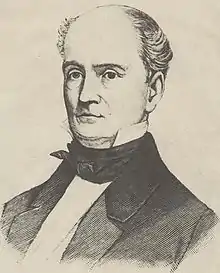
.jpg.webp)

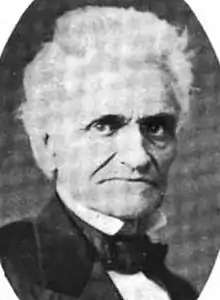

.jpg.webp)

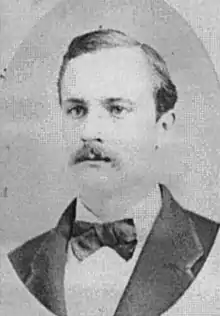
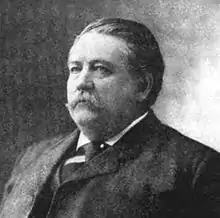
.jpg.webp)
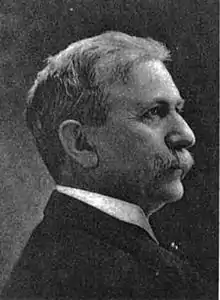
.jpg.webp)

.jpg.webp)
.jpg.webp)

